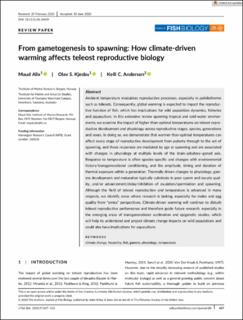| dc.description.abstract | Ambient temperature modulates reproductive processes, especially in poikilotherms such as teleosts. Consequently, global warming is expected to impact the reproductive function of fish, which has implications for wild population dynamics, fisheries and aquaculture. In this extensive review spanning tropical and cold‐water environments, we examine the impact of higher‐than‐optimal temperatures on teleost reproductive development and physiology across reproductive stages, species, generations and sexes. In doing so, we demonstrate that warmer‐than‐optimal temperatures can affect every stage of reproductive development from puberty through to the act of spawning, and these responses are mediated by age at spawning and are associated with changes in physiology at multiple levels of the brain–pituitary–gonad axis. Response to temperature is often species‐specific and changes with environmental history/transgenerational conditioning, and the amplitude, timing and duration of thermal exposure within a generation. Thermally driven changes to physiology, gamete development and maturation typically culminate in poor sperm and oocyte quality, and/or advancement/delay/inhibition of ovulation/spermiation and spawning. Although the field of teleost reproduction and temperature is advanced in many respects, we identify areas where research is lacking, especially for males and egg quality from “omics” perspectives. Climate‐driven warming will continue to disturb teleost reproductive performance and therefore guide future research, especially in the emerging areas of transgenerational acclimation and epigenetic studies, which will help to understand and project climate change impacts on wild populations and could also have implications for aquaculture. | en_US |
